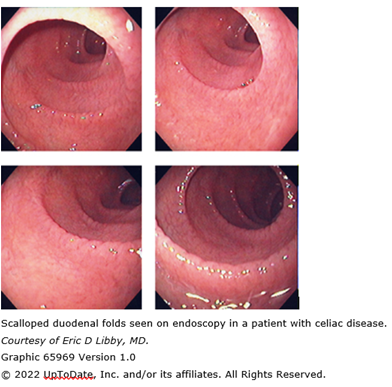
A 20-year-old white female presented to the GI clinic with a chief complaint of “fatigue and low blood count.” She is an elite athlete. She runs cross country for a division 1 university. Approximately three months ago, she noted significant fatigue after training regimens. Two months ago, she noted steadily decreasing times for her cross country runs. She also noted daily fatigue unrelated to training. She has a lifelong history of constipation, having two to three bowel movements per week. Over the last two months her bowel habits have changed. She now has one to two daily, formed, non-bloody bowel movements. She denies any other symptoms. Specifically, no weight loss, no abdominal pain and no GI bleeding. She has no chronic medical problems and does not take any medication, vitamins or supplements. Evaluation by her primary physician revealed an Hgb of 10.8 and a slightly decreased mean corpuscular volume. Of note, she states her grandmother (originally from western Ireland) has some type of “GI disease.”
What is the most likely etiology for this patient’s fatigue, anemia and change in bowel habits?
A) Irritable bowel syndrome
B) CDI (Clostridioides difficile infection)
C) Celiac disease
D) Peptic ulcer disease
The correct answer is C, celiac disease.
Practice Pearls
Celiac disease is an immune disorder triggered by gluten. It occurs in genetically predisposed individuals. There is a close association with human leukocyte antigen DR3-DQ2 and/or DR4-DQ8 gene locus.1
Gluten is a protein found in wheat, which helps foods maintain their shape and integrity. A peptide derived from gluten, gliadin, damages the small intestine.1
Celiac disease causes enteropathy of the mucosal layer of the small intestine. Pathologic changes found in duodenal biopsies include villous atrophy with complete loss of villi, crypt hyperplasia and increased intraepithelial lymphocytosis.2
U.S. prevalence is approximately 1:130. High-risk groups include first- and second-degree relatives of patients with celiac disease, Type 1 diabetes, autoimmune thyroiditis, and Down and Turner syndromes.1,3
Definitions of celiac disease include classic celiac disease (diarrhea and signs or symptoms of malabsorption), atypical celiac disease (minor gastrointestinal symptoms and usually extraintestinal manifestations, such as anemia or abnormal aminotransferases), latent celiac disease (a previously used term to describe celiac disease typically diagnosed in childhood and resolution of symptoms as an adult despite not adhering to a gluten-free diet) and refractory celiac disease (persistence of symptoms and villous atrophy despite adhering to a gluten-free diet).1
Gastrointestinal manifestations may include diarrhea with large, malodorous stools and weight loss. The severity of the histologic changes in the small bowel does not necessarily correlate with the severity of clinical manifestations.1,3
Image: Endoscopic findings include atrophic-appearing mucosa with loss of folds, nodularity and scalloping.1

Extraintestinal manifestations are common and include anemia due to malabsorption of iron, vitamin B12 or folate, dermatitis herpetiformis, atrophic glossitis, impaired coagulation due to malabsorption of vitamin K, osteoporosis and neuropsychiatric disease.1
The diagnostic workup typically begins with serologic tests. Tissue transglutaminase antibody IgA (t-TG-IgA) is the recommended test for the diagnosis of celiac disease in adults. An IgA antibody should also be measured. The gold standard for the diagnosis is duodenal mucosal biopsies. These tests need to be obtained while the patient is on a regular diet (gluten-containing diet).1,4
Management of celiac disease should adhere to the acronym CELIAC.4
Consultation with a dietitian experienced with celiac disease
Education about the disease
Lifelong adherence to a gluten-free diet
Identification and treatment of nutritional deficiencies
Access to an advocacy group
Continuous long-term follow-up by a multidisciplinary team
The risks of noncompliance with a gluten-free diet include an increased risk of vitamin deficiencies, lymphoma and small bowel adenocarcinoma.1
Women with poorly treated or undiagnosed celiac disease may have an increased risk of infertility, miscarriage and/or infants with congenital birth defects.1,3

Joseph Vicari, MD, MBA, FASGE
Rockford Gastroenterology Associates
Rockford, IL

Stacia Sackmaster, APN-BC
Rockford Gastroenterology Associates
Rockford, IL

Corrie Scott, APN-BC
Rockford Gastroenterology Associates
Rockford, IL
Stacia Sackmaster, APN-BC and Corrie Scott, APN-BC are family nurse practitioners at Rockford Gastroenterology Associates, Ltd. Joseph Vicari, MD, FASGE joined Rockford Gastroenterology in 1997 and has served as managing partner. He previously served as chair of the ASGE Practice Operations Committee and currently serves as councilor on the ASGE Governing Board.
- UpToDate Epidemiology, pathogenesis, and clinical manifestations of Celiac Disease in Adults. Diagnosis of Celiac Disease. Management of Celiac Disease. Retrieved from the UpToDate.com website, https://www.uptodate.com
- StatPearls. 2022, August 8. Celiac disease. Retrieved from https://www.statpearls.com
- Rubio-Tapia A, Hill ID, Kelly CP, Calderwood AH, Murray JA; American College of Gastroenterology. ACG clinical guidelines: diagnosis and management of celiac disease. Am J Gastroenterol. 2013;108:656. Epub 2013 Apr 23.
- Husby S, Murray JA, Katzka DA. AGA clinical practice update on diagnosis and monitoring of celiac disease-changing utility of serology and histologic measures: Expert review. Gastroenterology. 2019;156:885. Epub 2018 Dec 19.